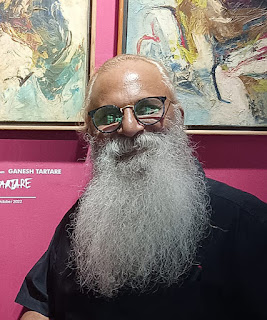A national level group art event Artival 2022 is being held at Expo Centre, World Trade Centre, Cuffe Parade, Mumbai on 11th, 12th and 13th Nov., 2022. It will showcase about 3000 artworks created by 300 artists from various regions of our country under one roof. The vivid participating artists are from different regions of the country having diverse backgrounds and culture. It is the intense urge of these artists to display their artworks alongwith those of master artists on a common platform in order to reach the prospective art collectors.
Different mediums and techniques have been used by the artists for their artwork, the prominent among them being oil, water colours, acrylic colours, charcoal, pastels, pen & ink, mix medium, marble, bronze, metal, fibre, wood etc. in realistic, semi-realistic and abstract styles. The art work presentations will include paintings , sculptures, artefacts, murals, installations etc. the numerous works will cover a wide range from traditional/ monumental/ spiritual/ historical heritage to landscapes, seascapes, urban and rural cityscapes, beauty of nature, tribal and folk arts and many more aspects including their modern versions.
The organisers intend to search obscure talent in different regions of India and promote them and their artwork through this event on a global level so as to reach the international art market.
Participating Art Galleries include:-
Chitrakathi Art Gallery, Mumbai, The Indian Gallery, Mumbai, I Quest Gallery, Mumbai, Aakar – A Contemporary Art, Kolkata, Urja The Art Gallery, Mumbai.
Participating Artists in this art exhibition include: Dilip Patil, Deepak Thakurdas, Prakash Ghadge, Padmanabh Bendre, Vitthal Hire, Shashikant Patade, Bhiva Punekar, Ashif Hossain, K Sadaf, R.C. Sharma, Nilesh Nikam, Devendra Nimbargikar, Dr. Shefali Samir Bhujbal, Dnyaneshwar Dhavale, Vaishali Ingle, Vaishali Desai, Sumana Dey, Reshma Shirke, Pratibha Goel, Neeta Verma, Vishal Sabley, Vishwajeet Kumar, Shalu Puria, Mita Vora, Seema Shah, Ishita Biswas, Bonobithi Biswas, Milind Thakur, Pankaj Naik Nimbalkar, Prajakta Ponkshe, Pallavi Nagwekar, Krishna Prakash Jagdale, Manjiri Joshi, Pavan Kumar D, Shrikant Poddar, Muskan Sagar, Mitlesh Sharma, Dr. Kashinath D.W, Satishkumar Wallepure, K.S. Kamatagoudar, Dr. Ashok Shatkar, B.N. Patil Kalaburagi, B.V. Kamaji, Meenakshi A.S. Guttedar, Nisha Singh, Tanishka Soni, B.R Uppin, Rajashekhar S, Kishor Kumar, Sanjay Kanihal, Milind Thakur, Mandar Khot, Yogita Arute, Sumant Shetty, Seema Arolkar, Kalpanand, Jui Bhagwat, Amita Acharya, Jyotsna Sonavane, Ravi Rahate, Seema Hadaoo, Gayatri Bhapkar, Namrata Goradia, Ram Rokade, Arjun Machivale, Mahesh Kadam, Rupesh Patil, Vaibhav Thakur, Namdev Patil, Nandkumar Thorat, Jayashree Savani, Santoshkumar Patil, Parshwa Nandre, Shailesh Gurav, Rohit Parab, Paneri Punekar, Kaustubh Kavathekar, Madhura Kulkarni, Mona Jain, Gautam Das, Sandeep Parkhi, Himanshi Rajawat, Anjali Kshirsagar, Murali Kumbhar, Yogesh Barve, Vijay Upadhye, Chaitanya Dalvi, Akshay Jadhav, Gorakh Gholap, Shrirang Badve, Rati Bhargava, Deepak B. Patil, Rahul Kirdak, Dhammapal Kirdak, Ahsan Abdul Rahim Ansari, M. Imtiyaz, Manoj Sonawane, Anil Chaugule, Anita Hasurkar, Govind Sirsat, Nanda Pathak, Janhavii Bhide, Sohnal Saxena, Dr. Jaai Karnik, Manisha Ogale, Varsha Sheth, Suvarna Bare, Rekha Thombare among others.
Press Release
From: 11th, 12th, 13th November 2022
"Artival Art Event 2022"
Modern & Contemporary Art Event
Expo Centre, 1st Floor,
World Trade Centre,
Colaba, Cuffe Parade, Mumbai 400 005
Contact: 9920804573 / 9833949788
Timing: 11am to 7pm





.JPG)




.jpg)
.jpg)